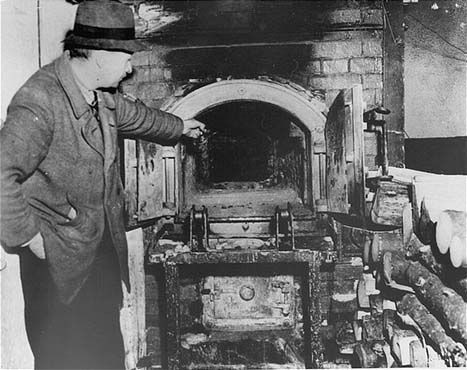Key and copyright. (In Czech)
The camp at Flossenbürg was opened at the beginning of May 1938, and its first prisoners were brought from Dachau. It was originally intended for allegedly criminal
and asocial
prisoners. The choice of a site close to the Czechoslovakian border was not random - Germany's leadership and army were already planning the destruction of Czechoslovakia. A major role was also played by the presence of significant granite deposits, since Flossenbürg was one of the camps where the aim was to make maximum use of prisoners' slave labour to arm Nazi Germany.

Prisoners' huts in the Flossenbürg concentration camp, 1942. (Photo: Bildarchiv Preussischer Kulturbesitz, courtesy of USHMM Photo Archives)
Although the camp was originally designed to hold 1 600 prisoners, only a year after its establishment its capacity was increased to 3 000. Despite various extensions, however, the camp was permanently overcrowded - in the last phase of its existence, in 1945, up to 15 000 prisoners were squeezed into it under terrible conditions. The camp's first prisoners were described as criminals
, - in fact, they consisted both of hardened criminals and people who found themselves in conflict with the Nazi regime because of small offences. Later however, German political prisoners from Dachau and Sachsenhausen were sent to the camp, and soon accounted for almost a third of all the prisoners. However, the criminal
prisoners filled all the important positions in the camp, and the green
kapos became tools of Nazi terror against other prisoners. In 1943,more than 4 000 prisoners - mostly political - were imprisoned in the camp, above all Poles, Soviet prisoners of war, Czechs, Belgians, French and Dutch people. From mid-1944, Jewish prisoners were also deported to the camp, the intention being that they should be used for slave labour before their planned murder.

Inside the prisoners' dormitories. Photograph taken after liberation by US troops on the 5th of May 1945. (Photo: National Archives, courtesy of USHMM Photo Archives)
At the beginning of 1945, a group of Sonderhäftlinge
(special prisoners
) were brought to the camp. They included members of the military resistance and high-ranking representatives of various states. They were interned separately from the other prisoners, and many of them were executed here, including the men of the 20th of July 1944
, members of the group that tried to assassinate Hitler.
To begin with, most of the prisoners worked in the granite quarries. The stone they quarried was used to build many of the Nazis' monumental buildings, such as the Reichsparteitagsgelände, the site of the party's rallies in Nuremberg. After the war began, most prisoners were moved on to weapons production. From February 1943 on, some prisoners were used as slave labourers in the Messerschmidt company's newly-built production halls, producing the Me 109 fighter aircraft. The camp also expanded geographically: gradually, over a hundred branches of it were set up in Bavaria, Saxony and in Western and Northern Bohemia.

A former French prisoner points to the crematorium, 4th of May 1945. (Photo: courtesy of USHMM Photo Archives)
However, the Nazis were not so much interested in the rational use of prisoners' labour as in their destruction through labour
. The prisoners worked under inhuman conditions, with insufficient food and continual bullying by the kapos. During the camp's existence, approximately 100 000 prisoners passed through it, of whom 30 000 can be demonstrably shown to have died here. Given the chaos in the registers at the end of the war, however, it is likely that there were more deaths than this. By summer of 1944, Flossenbürg had become a destination for evacuation transports
, death marches from camps that were being closed ahead of the Allied advance. On the 17th of April 1945, the first death march left Flossenbürg, heading for Dachau. Gradually over 10 000 starving and weakened prisoners were driven out, walking through the Bavarian countryside in several columns. After the war ended, some five thousand dead bodies were discovered alongside the route.
When American soldiers entered the camp on the 23th of April 1945, they found approximately 1 600 severely-weakened prisoners there. For several weeks after liberation, prisoners continued to die from the effects of their imprisonment.
-
Links:
-
Gedenkstätte Flossenbürg. Memorial on the site of the former camp.